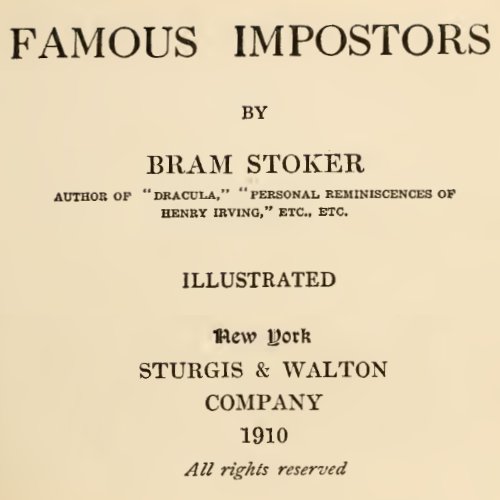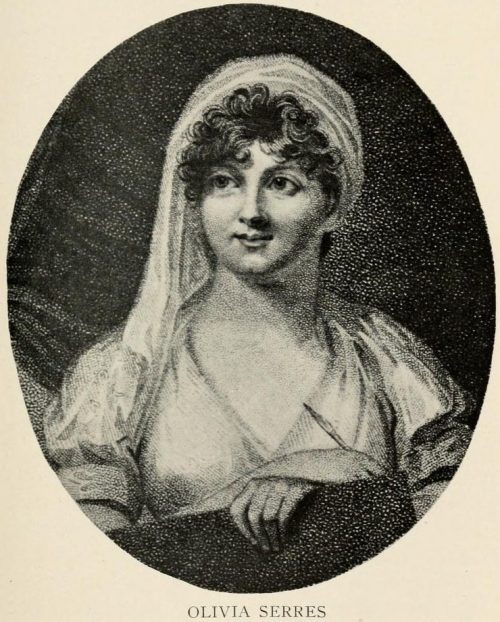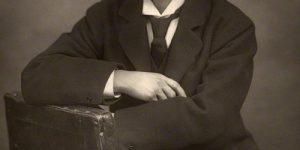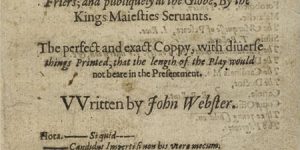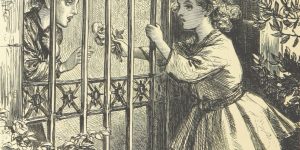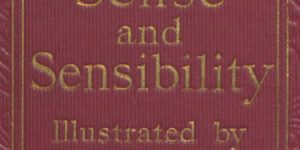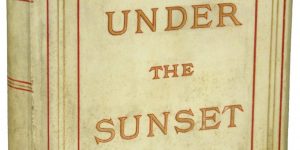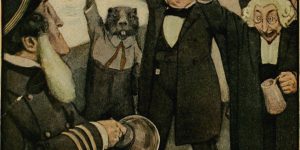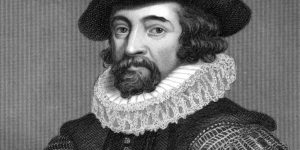Princess Olive : Famous Impostors by Bram Stoker
Famous Impostors : Pretender Princess Olive
by
Bram Stoker
Princess Olive
The story of Mrs. Olive Serres, as nature made it, was one thing; it was quite another as she made it for herself. The result, before the story was completely told, was a third; and, compared with the other, one of transcendent importance. Altogether her efforts, whatsoever they were and crowned never so effectively, showed a triumph in its way of the thaumaturgic art of lying; but like all structures built on sand it collapsed eventually. In the plain version—nature’s—the facts were simply as follows. She, and a brother of no importance, were the children of a house painter living in Warwick, one Robert Wilmot, and of Anna Maria his wife. Having been born in 1772 she was under age when in 1791 she was married, the ceremony therefore requiring licence supported by bond and affidavit. Her husband was John Thomas Serres who ten years later was appointed marine painter to King George III. Mr. and Mrs. Serres were separated in 1804 after the birth of two daughters, the elder of whom, born in 1797, became in 1822 the wife of Antony Thomas Ryves a portrait painter—whom she divorced in 1847. Mrs. A. T. Ryves twelve years later filed a petition praying that the marriage of her mother, made in 1791, might be declared valid and she herself the legitimate issue of that marriage. The case was heard in 1861, Mrs. Ryves conducting it in person. Having produced sufficient evidence of the marriage and the birth, and there being no opposition, the Court almost as a matter of course pronounced the decree asked for. In this case no complications in the way of birth or marriage of Mrs. Serres were touched on.
Robert Wilmot, the house-painter, had an elder brother James who became a Fellow of Trinity College, Oxford, and went into the Church, taking his degree of Doctor of Divinity. Through his College he was presented in 1781 to the living of Barton-on-the-heath, Warwickshire. The Statutes of his College contained a prohibition against marriage whilst a Fellow. James Wilmot D. D. died in 1807 leaving his property between the two children of Robert, after life-use by his brother. James and Robert Wilmot had a sister Olive, who was born in 1728 and married in 1754 to William Payne with issue one daughter, Olivia, born in 1759. Robert Wilmot died in 1812.
Out of these rough materials Mrs. Olive Serres set herself in due course to construct and carry out, as time and opportunity allowed, and as occasions presented themselves and developed, a fraudulent romance in real life and action. She was, however, a very clever woman and in certain ways—as was afterwards proved by her literary and artistic work—well dowered by nature for the task—crooked though it was—which she set for herself. Her ability was shown not only by what she could do and did at this time of her life, but by the manner in which she developed her natural gifts as time went on. In the sum of her working life, in which the perspective of days becomes merged in that of years, she touched on many subjects, not always of an ordinary kind, which shewed often that she was of conspicuous ability, having become accomplished in several branches of art. She was a painter of sufficient merit to have exhibited her work in the Royal Academy in 1794 and to be appointed landscape-painter to the Prince of Wales in 1806. She was a novelist, a press writer, an occasional poet and in many ways of a ready pen. She was skilled in some forms of occultism, and could cast horoscopes; she wrote, in addition to a pamphlet on the same subject, a book on the writings of Junius, claiming to have discovered the identity of the author—none other than James Wilmot D. D. She wrote learnedly on disguised handwriting. In fact she touched on the many phases of literary effort which come within the scope of those who live by the work of their brains. Perhaps, indeed, it was her facility as a writer that helped to lead her astray; for in her practical draughtsmanship and in her brain teeming with romantic ideas she found a means of availing herself of opportunities suggested by her reckless ambition. Doubtless the cramped and unpoetic life of her humble condition in the house-painter’s home in Warwick made her fret and chafe under its natural restraint. But when she saw her way to an effective scheme of enlarging her self-importance she acted with extraordinary daring and resource. As is usual with such natures, when moral restraints have been abandoned, the pendulum swung to its opposite. As she had been lowly she determined to be proud; and having fixed on her objective began to elaborate a consistent scheme, utilising the facts of her own surroundings as the foundation of her imposture. She probably realised early that there must be a base somewhere, and so proceeded to manufacture or arrange for herself a new identity into which the demonstrable facts of her actual life could be wrought. At the same time she manifestly realised that in a similar way fact and intention must be interwoven throughout the whole of her contemplated creation. Accordingly she created for herself a new milieu which she supported by forged documents of so clever a conceit and such excellent workmanship, that they misled all who investigated them, until they came within the purview of the great lawyers of the day whose knowledge, logical power, skill and determination were arrayed against her. By a sort of intellectual metabolism she changed the identities and conditions of her own relations whom I have mentioned, always taking care that her story held together in essential possibilities, and making use of the abnormalities of those whose prototypes she introduced into fictional life.
The changes made in her world of new conditions were mainly as follows: Her uncle, the Reverend James, who as a man of learning and dignity was accustomed to high-class society, and as a preacher of eminence occasionally in touch with Crown and Court, became her father; and she herself the child of a secret marriage with a great lady whose personal rank and condition would reflect importance on her daughter. But proof, or alleged proof, of some kind would be necessary and there were too many persons at present living whose testimony would be available for her undoing. So her uncle James shifted his place and became her grandfather. To this the circumstances of his earlier life gave credibility in two ways; firstly because they allowed of his having made a secret marriage, since he was forbidden to marry by the statutes of his college, and secondly because they gave a reasonable excuse for concealing his marriage and the birth of a child, publicity regarding which would have cost him his livelihood.
At this point the story began to grow logically, and the whole scheme to expand cohesively. Her genius as a writer of fiction was being proved; and with the strengthening of the intellectual nature came the atrophy of the moral. She began to look higher; and the seeds of imagination took root in her vanity till the madness latent in her nature turned wishes into beliefs and beliefs into facts. As she was imagining on her own behoof, why not imagine beneficially? This all took time, so that when she was well prepared for her venture things had moved on in the nation and the world as well as in her fictitious romance. Manifestly she could not make a start on her venture until the possibility vanished of witnesses from the inner circle of her own family being brought against her; so that she could not safely begin machinations for some time. She determined however to be ready when occasion should serve. In the meantime she had to lead two lives. Outwardly she was Olive Serres, daughter of Robert Wilmot born in 1772 and married in 1791, and mother of two daughters. Inwardly she was the same woman with the same birth, marriage and motherhood, but of different descent being (imaginatively) grand-daughter of her (real) uncle the Rev. James Wilmot D. D. The gaps in the imaginary descent having been thus filled up as made and provided in her own mind, she felt more safe. Her uncle—so ran her fiction—had early in his college life met and become friends with Count Stanislaus Poniatowski who later became by election King of Poland. Count Poniatowski had a sister—whom the ingenious Olive dubbed “Princess of Poland”—who became the wife of her uncle (now her grandfather) James. To them was born, in 1750, a daughter Olive, the marriage being kept secret for family reasons, and the child for the same reason being passed off as the offspring of Robert the housepainter. This child Olive, according to the fiction, met His Royal Highness Henry Frederick, Duke of Cumberland, brother of the King, George III. They fell in love with each other and were privately married—by the Rev. James Wilmot D. D.—on 4 March 1767. They had issue one daughter, Olive, born at Warwick 3 April 1772. After living with her for four years the Duke of Cumberland deserted his wife, who was then pregnant, and in 1771 married—bigamously, it was alleged—Lady Anne Horton, sister of Colonel Luttrell, daughter of Lord Irnham, and widow of Andrew Horton of Catton, Derbyshire. The (alleged) Royal Duchess died in France in 1774, and the Duke in 1790.
Thus fact and fiction were arrayed together in a very cunning way. The birth of Olive Wilmot (afterwards Serres) in 1772 was proved by a genuine registry. Likewise that of her daughter Mrs. Ryves. For all the rest the certificates were forged. Moreover there was proof of another Olive Wilmot whose existence, supported by genuine registration, might avert suspicion; since it would be difficult to prove after a lapse of time that the Olive Wilmot born at Warwick in 1772 daughter of Robert (the house-painter), was not the granddaughter of James (the Doctor of Divinity). In case of necessity the real date (1759) of the birth of Olive Wilmot sister of the Rev. James could easily be altered to the fictitious date of the birth of “Princess” Olive born 1750.
It was only in 1817 that Mrs. Serres began to take active measures for carrying her imposture into action; and in the process she made some tentative efforts which afterwards made difficulty for her. At first she sent out a story, through a memorial to George III, that she was daughter of the Duke of Cumberland by Mrs. Payne, wife of Captain Payne and sister of James Wilmot D. D. This she amended later in the same year by alleging that she was a natural daughter of the Duke by the sister of Doctor Wilmot, whom he had seduced under promise of marriage. It was not till after the deaths of George III and the Duke of Kent in 1820, that the story took its third and final form.
It should be noticed that care was taken not to clash with laws already in existence or to run counter to generally received facts. In 1772 was passed the Royal Marriage Act (12 George III Cap. 11) which nullified any marriage contracted with anyone in the succession to the Crown to which the Monarch had not given his sanction. Therefore Mrs. Serres had fixed the (alleged) marriage of (the alleged) Olive Wilmot with the Duke of Cumberland as in 1767—five years earlier—so that the Act could not be brought forward as a bar to its validity. Up to 1772 such marriages could take place legally. Indeed there was actually a case in existence—the Duke of Gloucester (another brother of the King) having married the dowager Countess of Waldegrave. It was of common repute that this marriage was the motive of the King’s resolve to have the Royal Marriage Act added to the Statute book. At the main trial it was alleged by Counsel, in making the petitioner’s claim, that the King (George III) was aware of the Duke of Cumberland’s marriage with Olive Wilmot, although it was not known to the public, and that when he heard of his marriage with Lady Anne Horton he was very angry and would not allow them to come to Court.
The various allegations of Mrs. Serres as to her mother’s marriage were not treated seriously for a long time but they were so persisted in that it became necessary to have some denial in evidence. Accordingly a law-case was entered. One which became a cause célèbre. It began in 1866—just about a hundred years from the time of the alleged marriage. With such a long gap the difficulties of disproving Mrs. Serres’ allegations were much increased. But there was no help for it; reasons of State forbade the acceptance or even the doubt of such a claim. The really important point was that if by any chance the claimant should win, the Succession would be endangered.
The presiding judge was the Lord Chief Justice, Lord Cockburn. With him sat Lord Chief Baron Pollock and the Judge Ordinary Sir James Wilde. There was a special jury. The case took the form of one in the English Probate Court made under the “Legitimacy Declaration Act.” In this case, Mrs. Ryves, daughter of Mrs. Serres, was the petitioner. Associated with her in the claim was her son, who, however, is of no interest in the matter and need not be considered. The petition stated that Mrs. Ryves was the legitimate daughter of one John Thomas Serres and Olive his wife, the said Olive being, whilst living, a natural-born subject and the legitimate daughter of Henry Frederick, Duke of Cumberland and Olive Wilmot, his wife. That the said Olive Wilmot, born in 1750, was lawfully married to His Royal Highness Henry Frederick, Duke of Cumberland, fourth son of Frederick Prince of Wales (thus being grandson of George II and brother of King George III), on 4 March 1767, at the house of Thomas, Lord Archer, in Grosvenor Square, London, the marriage being performed by the Rev. James Wilmot D. D., father of the said Olive Wilmot. That a child, Olive, was born to them on 3 April 1772, who in 1791 was married to John Thomas Serres. And so on in accordance with the (alleged) facts above given.
The strange position was that even if the petitioner should win her main case she would prove her own illegitimacy. For granting that the alleged Olive Serres should have been legally married to the Duke of Cumberland, the Royal Marriage Act, passed five years later, forbade the union of the child of such a marriage, except with the sanction of the reigning monarch.
In the making of the claim of Mrs. Ryves a grave matter appeared—one which rendered it absolutely necessary that the case should be heard in the most formal and adequate way and settled once for all. The matter was one affecting the legality of the marriage of George III, and so touching the legitimacy of his son afterwards George IV, his son afterwards William IV and his son the Duke of Kent, father of Queen Victoria—and so debarring them and all their descendants from the Crown of England. The points of contact were in documents insidiously though not overtly produced and the preparation of which showed much constructive skill in the world of fiction. Amongst the many documents put in evidence by the Counsel for Mrs. Ryves were two certificates of the (alleged) marriage between Olive Wilmot and the Duke of Cumberland. On the back of each of these alleged certificates was written what purported to be a certificate of the marriage of George III to Hannah Lightfoot performed in 1759 by J. Wilmot. The wording of the documents varied slightly.
It was thus that the claim of Mrs. Ryves and her son became linked up with the present and future destinies of England. These alleged documents too, brought the Attorney General upon the scene. There were two reasons for this. Firstly the action had to be taken against the Crown in the matter of form; secondly in such a case with the possibility of such vast issues it was absolutely necessary that every position should be carefully guarded, every allegation jealously examined. In each case the Attorney General was the proper official to act.
The Case of the Petitioners was prepared with extraordinary care. There were amongst the documents produced, numbering over seventy, some containing amongst them forty-three signatures of Dr. Wilmot, sixteen of Lord Chatham, twelve of Mr. Dunning (afterwards the 1st Baron Ashburton), twelve of George III, thirty-two of Lord Warwick and eighteen of H.R.H., the Duke of Kent, the father of Queen Victoria. Their counsel stated that although these documents had been repeatedly brought to the notice of the successive Ministers of the Crown, it had never been suggested until that day that they were forgeries. This latter statement was traversed in Court by the Lord Chief Baron, who called attention to a debate on the subject in the House of Commons in which they were denounced as forgeries.
In addition to those documents already quoted were the following certificates:
“The marriage of these parties was this day duly solemnized at Kew Chapel, according to the rites and ceremonies of the Church of England, by myself.
“J. Wilmot.”
“George P.”
“Hannah.”
Witness to this marriage
“W. Pitt.”
“Anne Taylor.”
May 27, 1759.* * * * *
April 17, 1759
“This is to Certify that the marriage of these parties (George, Prince of Wales, to Hannah Lightfoot) was duly solemnized this day, according to the rites and ceremonies of the Church of England, at their residence at Peckham, by myself.
“J. Wilmot.”
“George Guelph.”
“Hannah Lightfoot.”
Witness to the marriage of these parties,—
“William Pitt.”
“Anne Taylor.”* * * * *
“I hereby Certify that George, Prince of Wales, married Hannah Wheeler alias Lightfoot, April 17, 1759, but from finding the latter to be her right name I solemnized the union of the said parties a second time May the 27th, 1759, as the Certificate affixed to this paper will confirm.
“J. Wilmot.
Witness (Torn)”
* * * * *
The case for the Crown was strongly supported. Not only did the Attorney-General, Sir Roundell Palmer (afterwards Lord Chancellor and First Earl of Selborne) appear himself, but he was supported by the Solicitor-General, the Queen’s Advocate, Mr. Hannen and Mr. R. Bourke. The Attorney-General made the defence himself. At the outset it was difficult to know where to begin, for everywhere undoubted and unchallenged facts were interwoven with the structure of the case; and of all the weaknesses and foibles of the important persons mentioned, full advantage was taken. The marriage of the Duke of Gloucester to Lady Waldegrave had made him unpopular in every way, and he was at the time a persona ingrata at Court. There had been rumours of scandal about the King (when Prince of Wales) and the “Fair Quaker,” Hannah Lightfoot. The anonymity of the author of the celebrated “Letters of Junius,” which attacked the King so unmercifully, lent plausibility to any story which might account for it. The case of Mrs. Ryves, tried in 1861, in which her own legitimacy had been proved and in which indisputable documents had been used, was taken as a proof of her bona fides.
Mrs. Ryves herself was in the box for nearly the whole of three days, during which she bore herself firmly, refusing even to sit down when the presiding judge courteously extended that privilege to her. She was then, by her own statement, over seventy years of age. In the course of her evidence a Memorial to George IV was produced, written by her mother, Mrs. Serres, in which the word offspring was spelled “orfspring”; in commenting on which the Attorney-General produced a congratulatory Ode to the Prince Regent on his birthday in 1812, by the same author, in which occurred the line:
“Hail valued heir orfspring of Heaven’s smile.” Similar eccentric orthography was found in other autograph papers of Mrs. Serres.
The Attorney-General, in opposing the claim, alleged that the whole story of the Duke of Cumberland’s marriage to Olive Wilmot was a concoction from beginning to end, and said that the mere statement of the Petitioner’s case was sufficient to stamp its true character. That its folly and absurdity were equal to its audacity; in every stage it exposed itself to conviction by the simplest tests. He added that the Petitioner might have dwelt so long upon documents produced and fabricated by others, that, with her memory impaired by old age, the principle of veracity might have been poisoned, and the offices of imagination and memory confounded to such an extent that she really believed that things had been done and said in her presence which were in fact entirely imaginary. No part of her story was corroborated by a single authentic document, or by a single extrinsic fact. The forgery, falsehood and fraud of the case were proved in many ways. The explanations were as false and feeble as the story itself. “I cannot of course,” he said, “lay bare the whole history of the concoction of these extraordinary documents, but there are circumstances which indicate that they were concocted by Mrs. Serres herself.”
Having commented on some other matters spoken of, but regarding which no evidence was adduced, he proceeded to speak of the alleged wife of Joseph Wilmot D. D., the Polish Princess, sister of Count Poniatowski, afterwards elected King of Poland (1764), who was the mother of his charming daughter, Olive. “The truth is,” said Sir Roundell, “that both the Polish Princess and the charming daughter were pure myths; no such persons ever existed—they were as entirely creatures of the imagination as Shakespeare’s Ferdinand and Miranda.”
As to the documents produced by the Petitioners he remarked:
“What sort of documents were those which were produced? The internal evidence proved that they were the most ridiculous, absurd, preposterous series of forgeries that the perverted ingenuity of man ever invented … they were all written on little scraps and slips of paper, such as no human being would ever have used for the purpose of recording transactions of this kind, and it would be proved that in every one of these pieces of paper the watermark of date was wanting.”
This was but a new variant of the remark made by the Lord Chief Justice, just after the putting-in of the alleged marriage Certificate of the Prince of Wales and Hannah Lightfoot:
“The Court is, as I understand, asked solemnly to declare, on the strength of two certificates, coming I know not whence, written on two scraps of paper, that the marriage, the only marriage of George III which the world believes to have taken place, between His Majesty and Queen Charlotte, was an invalid marriage, and consequently that all the Sovereigns who have sat on the throne since his death, including Her present Majesty, were not entitled to sit on the throne. That is the conclusion which the Court is asked to come to upon these two rubbishy pieces of paper, one signed ‘George P.,’ and the other ‘George Guelph.’ I believe them to be gross and rank forgeries. The Court has no difficulty in coming to the conclusion, even assuming that the signatures had that character of genuineness which they have not, that what is asserted in these documents has not the slightest foundation in fact.”
With this view the Lord Chief Baron and the Judge-Ordinary entirely concurred, the former adding:
“… the declarations of Hannah Lightfoot, if there ever was such a person, cannot be received in evidence on the faith of these documents … the only issues for the jury are the issues in the cause and this is not an issue in the cause, but an incidental issue…. I think that these documents, which the Lord Chief Justice has treated with all the respect which properly belongs to them, are not genuine.”
Before the Attorney General had finished the statement of his case, he was interrupted by the foreman of the jury, who said that the jury were unanimously of opinion that there was no necessity to hear any further evidence as they were convinced that the signatures of the documents were not genuine. On this the Lord Chief Justice said:
“You share the opinion which my learned brothers and I have entertained for a long time; that every one of the documents is spurious.”
As the Counsel for the Petitioners had “felt it his duty to make some observations to the jury before they delivered their verdict,” and had made them, the Lord Chief Justice summed up. Towards the conclusion of his summing-up he said, in speaking of the various conflicting stories put forth by Mrs. Serres:
“In each of the claims which she made at different times, she appealed to documents in her possession by which they were supported. What was the irresistible inference? Why, that documents were from time to time prepared to meet the form which her claims from time to time assumed.”
The jury, without hesitation, found that they were not satisfied “that Olive Serres, the mother of Mrs. Ryves, was the legitimate daughter of Henry Frederick Duke of Cumberland and Olive his wife; and they were not satisfied that Henry Frederick, Duke of Cumberland, was lawfully married to Olive Wilmot on the 4th of March 1767….”
The case of Mrs. Serres is an instance of how a person, otherwise comparatively harmless but afflicted with vanity and egotism, may be led away into evil courses, from which, had she realised their full iniquity, she might have shrunk. The only thing outside the case we have been considering, was that she separated from her husband; which indeed was an affliction rather than a crime. She had been married for thirteen years and had borne two children, but so far as we know no impropriety was ever alleged against her. One of her daughters remained her constant companion till her twenty-second year and through her long life held her and her memory in filial devotion and respect. The forethought, labour and invention which she devoted to the fraud, if properly and honestly used, might have won for her a noteworthy place in the history of her time. But as it was, she frittered away in criminal work her good opportunities and great talents, and ended her life within the rules of the King’s Bench.
Famous Impostors
Chapter I. Pretenders
A. Perkin Warbeck
B. The Hidden King
C. Stephan Mali
D. The False Dauphins
E. Princess Olive
Chapter II. Practitioners of Magic
A. Paracelsus
B. Cagliostro
C. Mesmer
Chapter III.
The Wandering Jew
Chapter IV.
John Law
Chapter V. Witchcraft and Clairvoyance
A. Witches
B. Doctor Dee
C. La Voisin
D. Sir Edward Kelley
E. Mother Damnable
F. Matthew Hopkins
Chapter VI.
Arthur Orton (Tichborne claimant)
Chapter VII. Women as Men
A. The Motive for Disguise
B. Hannah Snell
C. La Maupin
D. Mary East
Chapter VIII. Hoaxes, etc.
A. Two London Hoaxes
B. The Cat Hoax
C. The Military Review
D. The Toll-Gate
E. The Marriage Hoax
F. Buried Treasure
G. Dean Swift’s Hoax
H. Hoaxed Burglars
I. Bogus Sausages
J. The Moon Hoax
Chapter IX.
Chevalier d’Eon
Chapter X.
The Bisley Boy

